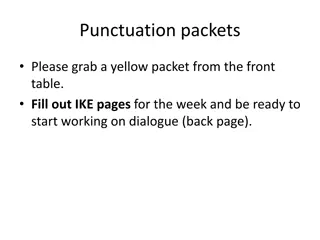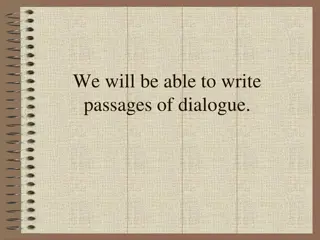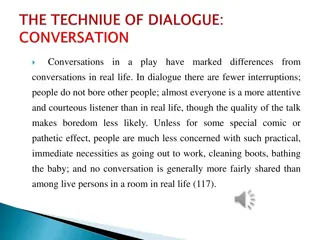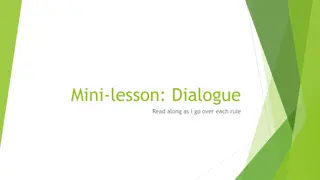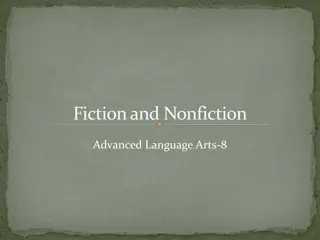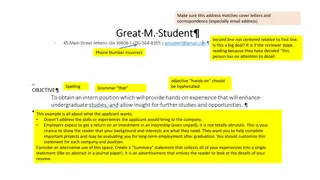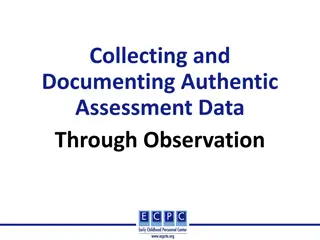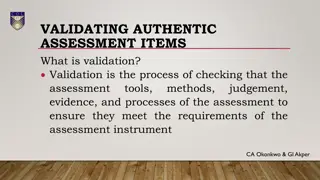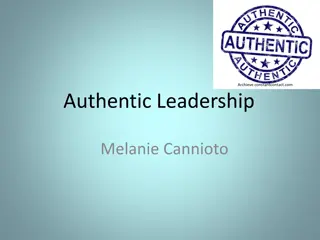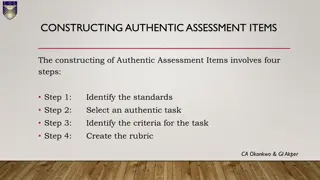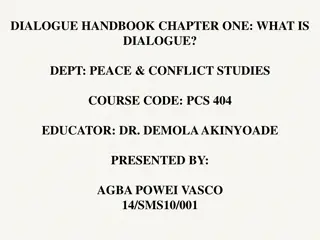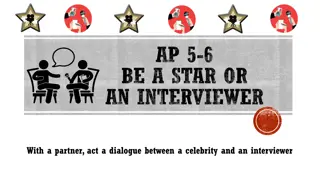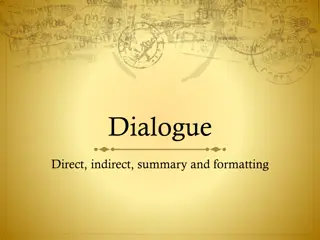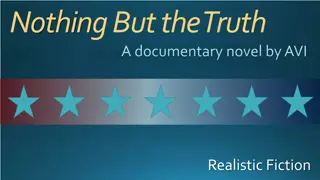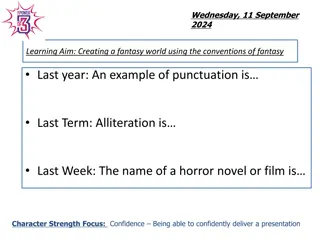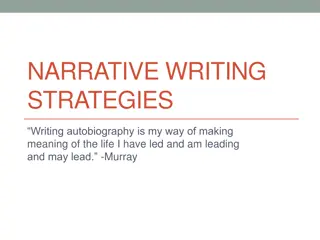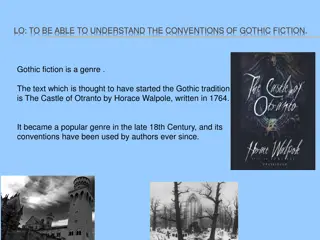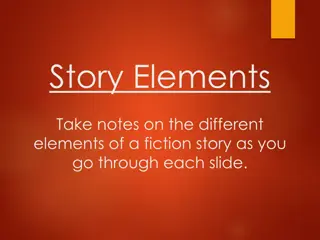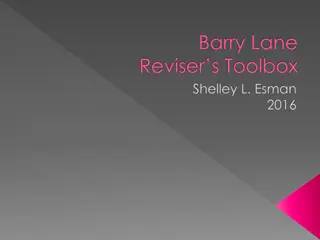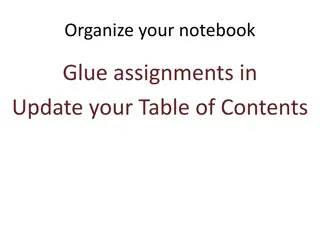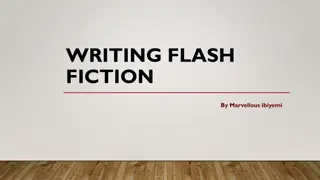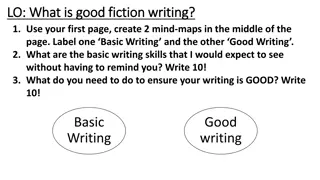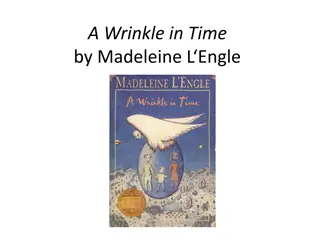Crafting Authentic Fiction: Detail and Dialogue for Time and Place
Explore the art of writing in specific time periods and locations, infusing authenticity through detailed research and engaging dialogue. Uncover strategies for creating a vivid setting, understanding character backgrounds, and setting the right mood. Discover resources for researching historical details and language nuances to enrich your narrative.
Download Presentation

Please find below an Image/Link to download the presentation.
The content on the website is provided AS IS for your information and personal use only. It may not be sold, licensed, or shared on other websites without obtaining consent from the author. Download presentation by click this link. If you encounter any issues during the download, it is possible that the publisher has removed the file from their server.
E N D
Presentation Transcript
WRITING DETAIL AND DIALOGUE TO TIME AND PLACE Maryka Biaggio, PhD www.marykabiaggio.com Sign up for newsletter to enter drawing THE WRITERS MILL JANUARY 2023
Presentation Goals Discuss ways to research details for setting, period, and dialogue Provide guidance on how to bring authenticity to your writing through detail and dialogue
Detail and Dialogue: Things to Consider 1. What time period are you writing in? 2. Where is your novel taking place what country and region? 3. What are the educational levels, races/ethnicities, occupations, and socioeconomic classes of your characters? 4. What differences do you want to showcase among your characters? 5. What mood are you trying to create?
Researching DetailsNear History Newspaper Articles. Can provide rich detail about events, prices of goods, even ideas for scenes. Newspapers.com is a subscription service. Diaries and Letters. Can provide information about daily life, habits, and sometimes surprising tidbits. Census and Vital Records. Can provide information about names of occupations, causes of death. Period Novels, Nonfiction Books, Movies. Can provide a sense of language, customs, norms, and place.
Researching Language Online thesaurus and dictionary: https://www.thesaurus.com https://www.dictionary.com Check and compare frequency of use of words and phrases at Google s Ngram Viewer: https://books.google.com/ngrams/ Check the etymology of words at https://www.etymonline.com Slang Dictionary for colorful language: http://onlineslangdictionary.com
Researching Details Distant History or Unfamiliar Lands Diaries and Letters. Can provide information about daily life, habits, and sometimes surprising tidbits. Nonfiction books. Can provide information about occupations, transportation, foods, etc. Travel and Local Tours. Can foster a deep understanding of place and its history. Period Novels or Nonfiction Books. Can provide a sense of language, customs, norms, and place.
Newspaper Articles THE BROOKLYN STANDARD UNION January 23, 1924 GIRL BANDIT ADDS ANOTHER TO LONG LIST OF HOLDUPS The elusive girl bandit she of the shorn locks and pretty face made another move last night in the game of checkers she has been playing with the police for a month now. Accompanied by her steady companion, the mysterious, tall young man, she went to a grocery store at 241 Albany Avenue, held up the proprietor and a woman customer who happened in, and then escaped with $55 in cash. The girl failed to leave behind one of the mocking notes as in other robberies. All attempts to give a humorous touch to her aggressions against the law were abandoned in this instance. She was just a bandit, pure and simple.
Diaries and Letters November 14, 1928 Dear Helen, At the risk of subjecting myself to further complaints (for you seem bent on misapprehending everything I say and rattling off claims to our friends about my improvident ways ), I must question your decision to embark on this journey. It forces us to communicate at long and uncertain distances and intervals. It requires funds that are needed for more basic exigencies, such as the maintenance of the house and the girls general comfort. I ask that you make this a short and hopefully rejuvenating vacation rather than the crack-brained expedition you seem set on.
Period Novels Sister Carrie (1900), Theodore Dreiser Theater of all genres vaudeville, Shakespeare, musicals with choruses of scantily clad dancing girls, melodramas, drawing-room comedies was popular after the Civil War. Shops: florist, furriers, haberdashers, confectioners Masher one whose dress or manners are calculated to elicit admiration of susceptible women. Elevator man Ladies rustled by in dresses of stiff cloth, rouged and powdered cheeks and lips, scented hair Prince Albert coat (a fine man s coat) Hornswaggled Coal heavers with great loads to shovel Blinking lines of gas-lamps
Finding Period Novels Website The Books of the Century was compiled by Daniel Immarwahr at UC Berkeley and lists top sellers of the 20th Century: https://www.ocf.berkeley.edu/%7Eimmer/booksmain Wikipedia has a list of novels published in the 1800s at https://en.wikipedia.org/wiki/Category:1800s_novels To find novels about different places, try Goodreads Browse Lists and search the lists for places.
Utilizing Nonfiction Books Sin in the Second City, Herbert Asbury Druggists stocked $1 bottles of Hibbard s Herb Extract, touted for itching, burning, and smarting skin and female weakness Quack doctors Penny arcades and nickel theaters Puddle-deep rugs and gilded spittoons Brougham Sporting house
Libraries and Librarians Go to the stacks and look for books that may be helpful. Use librarians to research off-the-beaten path details.
Deciding What Details to Include Do include: Details that readers expect for your genre Details that show important settings for the story Details that paint a scene that matches novel s mood/feelings Details that enlighten character s perspective Details that highlight story theme/big idea Refer to your compendium Look for places to insert details: greetings, heated talk, dialogue or description Do not include: Everything you ve learned about the setting or period Details that bog down the narrative Business-as-usual details
The Purposes of Dialogue Examples from a detective novel: Show character or relationships A girl wants to see you. She s a knockout. Shoo her in, darling. Provide background I inquired at the hotel about a reliable private detective. Convey/escalate conflict or threat I m deathly afraid of him, of what he might do. Suggest subtext More than idle curiosity prompted my question.
Dialogue Conventions Give each character their own paragraph; some white space is appealing. Put at beginning or end of paragraph. Use double quotes for dialogue (unless otherwise recommended by publisher). Internal dialogue can be set off by she thought tag, by italics, or by context.
Dialogue Dos Ideally, use to accomplish more than one thing. Keep it short and concise. Give individuals different styles of speech. Push to deepen dialogue writers can revise dialogue, real speakers can t. Read dialogue aloud to check for authenticity. Use contractions freely.
Dialogue Donts Avoid obvious dialect, e.g., goin fishin . Instead, focus on word choice or cues. Don t include mundane dialogue unless you want to highlight the mundane. Don t overuse dialogue to convey information. Avoid on-the-nose dialogue. Instead, pay attention to subtext.
Subtext in Dialogue 1 Example from an American novelist: I just want to live simply and pay attention to what s happening each day. And come sleep with you at night. It turns out we re not finished with changes and excitements. And not all dried up in body and spirit. And we re not even doing what people think we re doing. Do you want to? Addie said That s entirely up to you.
Using Dialogue Tags He/she said/asked are the most straightforward dialogue tag and are almost invisible. This should be primary tag used. Don t use he/she said/asked for every line of speech. Usually only needed every few lines. Action tags can provide a picture of speaker s behavior. Internal dialogue can show what speaker is thinking and not saying.
Telling Dialogue 1 Example a classic American novel: A saucy manner does not go down with me. I will not be bullied. Earlier tonight I gave some thought to stealing a kiss from you, though you are very young, and sick and unattractive to boot, but now I am of a mind to give you five or six good licks with my belt. One would be as unpleasant as the other.
Telling Dialogue 2 Condensed example a well-known American author: What you be dig for? Worm grub? We re cultivating the soil, sister. My father mopped his brow again and launched into the parable of the one mustard seed falling on a barren place, and the other one on good soil. Mama Tataba seemed not to listen. You got to be make hills. He said at last. I ve been tending the soil ever since I could walk behind my father.
Telling Dialogue 3 Condensed example a prolific American author: I have plans for you, Norma Jean. For us, Gladys said. Norma Jean s piano lessons continued sporadically. And she had occasional voice lessons. Miss Flynn told Gladys, Your little girl has a sweet, sincere personality. But right now Jess Flynn spoke softly, so Norma Jean might not hear she really has no voice at all. Gladys said, She will.
Dialogue For Time and Place Use details specific to the time/place. Let us make the fishmonger our last stop. Signal a different time period with formal or anachronistic speech. Of the many people who thronged my life, I counted him the most engaging. Use jargon/sayings of time/place. God s teeth, he s foiled us again.
Maryka Biaggio, PhD QUESTIONS?
Maryka Biaggio, PhD Author of: Parlor Games (Doubleday) Eden Waits (Sunbury Press) The Point of Vanishing (Sunbury Press) The Model Spy (Sunbury Press) Sign up for my newsletter at my website: www.marykabiaggio.com


